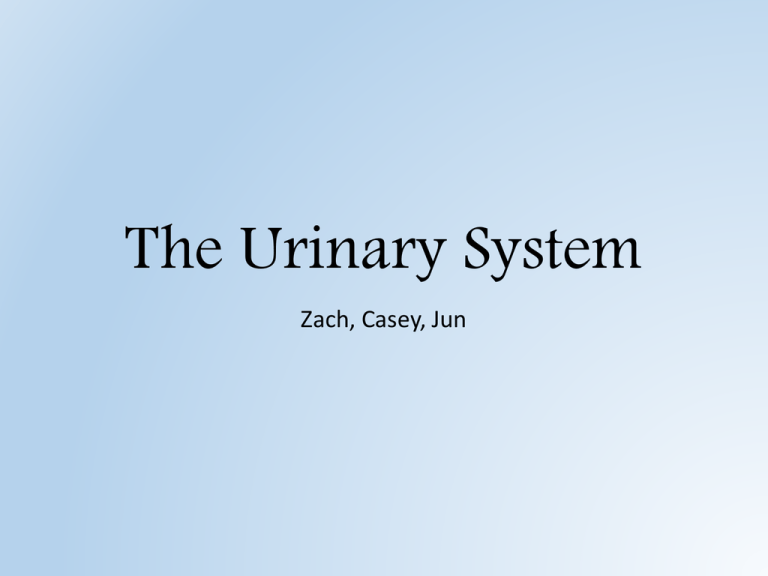The Urinary System
advertisement

The Urinary System Zach, Casey, Jun The Urinary System • The function of the Urinary system is to filter the blood and urine as well as help regulate certain metabolic processes through the kidneys. • The urinary system also excretes the waste, which is what is left over, so that the body is not poisoned. Structures Of the Urinary System The Kidneys • Two within a person • Filtration organs • Adult Kidney is about 6x12x3 cm (WxHxL) • Enclosed in tough, fibrous capsule • Contains about 1 million nephrons Ureters • Two Ureters • About 25 cm. long each • Transport the liquids to the bladder • Wall has three layers • Inner – Mucous Coat • Middle – Muscular Coat (smooth muscle fibers) • Propels the urine • Outer – Fibrous Coat (connective tissue) The Bladder • One bladder • Holds the liquids filtered from the kidneys • Hollow, distensible, and muscular • Receives from the Ureters • In the pelvic cavity • Pressure from surrounding organs changes its shape • On the inner floor consists a trigone • Trigone has 3 opening of ureters • Has a neck which is funnel-shaped on the anterior side The Bladder (Cont.) • Four layers • Inner – Mucous Coat (Several thicknesses (which change with the bladder as it expands and contracts) of transitional epithelial cells) • 2nd layer – Submucous Coat (Connective tissue and many elastic fibers) • 3rd Layer – Muscular Coat (Coarse bundles of smooth muscle fibers and when together make the detrusor muscle which surrounds the neck of the bladder forms an internal urethral sphincter. Sustained contractions prevents the emptying of the bladder) • Outer – Serous Coat (Parietal Peritoneum (only on the upper surface) and connective tissue (everywhere except the upper surface)) Urethra • Is a tube which excretes the fluids within the bladder to the outside of the body • Wall is lined with Mucous Membrane and a thick layer of smooth muscle tissue • Contains many mucous glands which are called urethral glands secreting mucous into the urethral canal Functions Of the Urinary System Urine Formation - Glomerular Filtration • Urine is formed beginning with glomerular filtration. The force of blood pressure forces the filtration process to begin, but most of the fluids from so are reabsorbed into the blood stream. By the colloid osmotic pressure of the plasma. The nephrons use two capillaries to work through. The first capillary bed is specialized to filter, and instead of forming interstitial fluid, the filtered fluid (filtrate) moves into the renal tubule, where much of it becomes urine. Urine Formation – Tubular Reabsorption • Moves from the tubular fluid back in the blood within the tubular capillary • Kidney specifically reclaims the perfect amounts of substances, such as water, electrolytes, and glucose which the body requires. Urine Formation – Tubular Secretion • Substances which the body must eliminate, such as hydrogen ions and some toxins, are removed even faster than through filtration itself. • Is the reverse process: • Moving substances from the blood stream within peritubular capillary into the renal tubule. Blood Travel Within a Kidney • Fluid flows though the renal corpuscle and within that it goes through a cluster of blood capillaries called glomerulus • The glomerulus capillaries filter the fluids coming through the kidneys • There is then a glomerular capsule which surrounds the glomerulus and receives the fluid which the glomerulus filters • This is near the proximal end of a renal tubule and the renal tubule leads away from the glomerular capsule and becomes highly coiled (this is called the proximal convoluted tubule) • The proximal convoluted tubule dips down towards the pelvis, becoming the descending limb of the nephron loop (also called the “loop of Henle”) Blood Travel Within a Kidney (Cont.) • The tubule then curves up toward the renal corpuscle forming the ascending limb of the nephron loop • The ascending limb then returns to the region of the renal corpuscle becoming highly coiled and renamed to the distal convoluted tubule • Then, the renal cortex is formed from a merging of several nephrons which then turn into collecting ducts (which is not part of a nephron) • This then turns into the renal medulla and enlarges as the other convoluted tubules join in • This results in the tube emptying into a minor calyx through an opening in the renal papilla Smaller Units Of the Urinary System Nephron • Consists of a Renal Corpuscle and a Renal Tubule • Renal Corpuscle • The renal corpuscle is a tightly coiled pack containing the glomerulus • The renal tubule is what the fluid flows through Urine Composition • The composition of urine reflects the amounts of water and solutes that the kidneys must eliminate from the body or retain in the internal environment to maintain homeostasis. • The composition varies due to diet • Urine is normally around 95% water, and usually contains urea and uric acid. • Urine may also contain a trace of amino acids and some electrolytes, which also depend on the diet. Urea • Urea is a byproduct of amino acid catabolism. • Urea’s plasma concentration reflects the amount of protein within the diet. • About 50% is reabsorbed and the remainder is excreted in urine. • Urea enters the renal tubule by filtration. Uric Acid • Uric acid is produced by the metabolism. • It is specifically the metabolism of certain organic bases and nucleic acids. • Uric acid is reabsorbed through active transport normally present though glomerular filtration. A small amount is secreted into the renal tubule and is excreted in urine. Diseases Of the Urinary System Cystocele • Cystocele is a hernia-like disorder in women which occurs when the wall between the bladder and vagina weakens. This causes the bladder to drop or sag into the vagina. • Urine leakage • Bladder not emptying completely • When doing any act which increases pressure upon the bladder, it is easy for urine to leak due to the opening to the urethra stretching Internal Cystitis • Body miscommunicates pain from the colon to the bladder (have pain in the bladder) • Mostly women suffer from this disease • Spicy foods, citrus and caffeine are a few of the foods causing Internal Cystitis • People feel the urge to urinate up to 50 times a day • The nerves within the pelvic region are all bunched together (the bladder, colon and prostate) into the same region of the spinal cord near the tailbone • When all are sending pain messages, the receptors get overloaded causing the pain to be constantly on whereas normally it is only small, short bursts of pain received • Only way to treat is rectally with an anesthetic in a suppository or gel, or perhaps an anesthetic patch applied to pelvic skin. Kidney Stone • Anyone can get kidney stones • Men affected more than women • It is a solid piece of combined material which is normally found within the urine becoming highly concentrated • The stone can stay in the kidney or move down the urinary tract • A small stone can move causing little to no pain whereas a larger stone may get stuck along the urinary tract and can block urine flow which could cause severe pain or bleeding Kidney Stone (Cont.) • People who have any of the following are at an increased risk of gaining kidney stones: • • • • • • • • • • • • Hypercalciuria Family history (of kidney stones) Cystic kidney diseases chronic inflammation of the bowel hyperparathyroidism renal tubular acidosis Cystinuria hyperuricosuria hyperoxaluria Gout blockage of the urinary tract a history of gastrointestinal tract surgery Kidney Stone (Cont.) • 4 Types • Calcium Stones • Most common • Uric acid stones • Form when the urine is stubbornly acidic • Struvite stones • Formed from kidney infections • Cystine stones • A genetic disorder, which causes cysteine to leak through the kidneys and into the urine that forms crystals that band together creating stones Kidney Stone (Cont.) • Two (of the three) ways listed can be used to remove the kidney stone • Shock wave lithotripsy • Lithotripter (a machine) is used to crush the stone • Ureteroscopy • A long tube-like instrument with an eyepiece and basket is used to “fish” or grab the stone or to break it with laser energy • Having a healthy diet can help to prevent kidney stones End of Presentation Thank you for staying awake! Works Cited "NewYork-Presbyterian. The University Hospital of Columbia and Cornell." Cystocele. The New York Presbyterian, 30 Nov. 2008. Web. 07 May 2013. <http://nyp.org/health/urologycystocel.html>. "Strange New Source of Bladder Pain Discovered." Strange New Source of Bladder Pain Discovered. LiveScience, 11 Sept. 2008. Web. 07 May 2013. <http://www.livescience.com/7563strange-source-bladder-pain-discovered.html>. "National Kidney and Urologic DiseasesInformation Clearinghouse (NKUDIC)." Kidney Stones in Adults. NIDDK, 28 Jan. 2013. Web. 07 May 2013. <http://kidney.niddk.nih.gov/KUDiseases/pubs/stonesadults/index .aspx>. Navigation Opening Structures Functions Other Diseases







